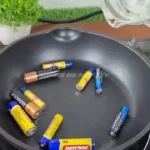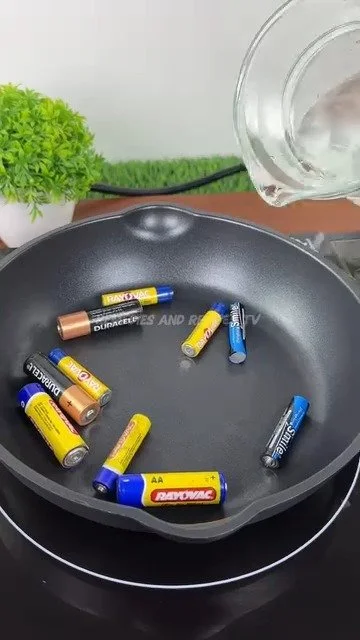Don’t Throw Away Your Dead Batteries Just Yet!
Have you ever found yourself frustrated with weak batteries that seem to have given up? This simple method using boiling and cold water can breathe new life into your old batteries! After testing it myself, I was surprised by the results and couldn’t wait to share my insights on how you can try this handy trick at home.
Why Make This Recipe
- Cost-Effective: Save money by reviving batteries that would otherwise be tossed away.
- Simple and Convenient: All you need are everyday kitchen items, making it easy to try out whenever you find a dying battery.
- Eco-Friendly: This method is a sustainable option that reduces waste and promotes recycling of batteries.
- Quick Results: With just a bit of boiling and cooling, you can bring back batteries in a matter of minutes!
- Satisfaction: There’s something incredibly gratifying about reviving a seemingly useless item and putting it back to use.
I love this technique because it highlights just how resourceful we can be when faced with everyday challenges—plus, it’s a fun experiment that can spark conversation!
Recipe Overview
- Prep Time: 5 minutes
- Cook Time: 10 minutes
- Total Time: 15 minutes
- Servings: N/A (depends on the number of batteries)
- Difficulty Level: Easy
- Cooking Method: Boiling and cooling
This technique involves a simple two-step process: boiling the batteries in water followed by a quick cold water immersion to rejuvenate them.
My Experience Making This Recipe
While putting this method to the test, I faced a couple of challenges, mainly ensuring the water temperature was just right. Too hot, and you risk damaging the battery casing, but too cool won’t yield results. After a few trials, I learned that a quick check on the water’s temperature made all the difference.
How to Revive Your Batteries
To start, you’ll need to gather a pot for boiling water and a bowl for your cold water bath. Begin by filling the pot with enough water to cover the batteries and bringing it to a boil. Once boiling, reduce the heat slightly, add the batteries (making sure they’re not touching each other), and let them simmer for about 10 minutes. Afterward, transfer them immediately into a bowl filled with ice-cold water for another 5 minutes. Patience is key here; allow them to cool completely before testing.
Expert Tips for Success
- Choose the Right Batteries: This method works best on alkaline batteries, especially AA and AAA types. Avoid trying it on lithium or rechargeable batteries.
- Use a Thermometer: To prevent overheating, use a kitchen thermometer to keep track of the water temperature. Aim for around 160°F (71°C) post-boil.
- Don’t Overcrowd: Make sure the batteries are spaced out in the boiling water; overcrowding can prevent even heating.
- Safety First: Wear gloves and be cautious when handling hot items to avoid burns.
- Test Before You Toss: Always test batteries after the treatment. Some may only regain partial life and are best reserved for low-drain devices.
How to Serve Your Revived Batteries
While this isn’t a recipe you’ll serve at dinner, consider these tips for what to do next:
- Organize Your Batteries: Group revived batteries together in a drawer or container, so you remember they’ve been treated.
- Mix and Match: Pair revived batteries with devices that require less power, making the most of their renewed life.
- Check Compatibility: Make sure the devices you plan to use them in are suitable for potentially weaker batteries.
Storage and Reheating Guide
Once treated, store your batteries in a cool, dry place. Ideally, keep them in their original packaging to avoid confusion with new ones. For used batteries that didn’t regain life, ensure they’re disposed of at designated recycling facilities. Avoid freezing batteries as this can permanently damage them.
Recipe Variations
- For Different Types of Batteries: Experiment with larger AA batteries by boiling them slightly longer; however, keep in mind that results may vary.
- Kid-Friendly Use: Turn this into a science experiment with kids by discussing why batteries lose power and how they can be revived.
- Heat-Free Method: Some recommend leaving dead batteries in bright sunlight for a few hours (not always effective, but worth a shot!).
Nutritional Highlights
While reviving batteries isn’t about food, it’s important to consider the environmental impact of throwing them away. Reviving promotes a better ecosystem.
Troubleshooting Common Issues
- Battery Is Still Weak: If a battery doesn’t regain full functionality, it may be too far gone—don’t be discouraged! It’s normal for some batteries not to respond at all.
- Battery Leaks: If you notice any leakage from the battery, stop using it immediately as it can be hazardous. Make sure to wear gloves.
- Heat Damage: If the batteries feel excessively hot after boiling, it’s best to discard them, as overheating can lead to damaged internal components.
Frequently Asked Questions
-
Can I revive rechargeable batteries with this method?
No, this technique is primarily effective for alkaline batteries. For rechargeable, consider their specific charging methods instead. -
What should I do if batteries are leaking?
Dispose of leaking batteries immediately and handle them carefully using gloves. They can be hazardous. -
How often should I try reviving batteries?
This method isn’t foolproof; only try to revive batteries once or twice before replacing them if they’re not holding charge. -
How do I know if a revived battery is safe to use?
Always check for physical damages like bulging or leakage. If they seem fine and hold a charge, they should be safe for low-drain devices.
By following these tips and insights, you’ll not only extend the life of your batteries but also engage in an eco-friendly practice that can spark intrigue and discussions in your home. Happy reviving!

How to Revive Dead Batteries
- Total Time: 15 minutes
- Yield: Depends on the number of batteries
- Diet: N/A
Description
Learn how to bring dead batteries back to life using boiling and cold water methods – a cost-effective and eco-friendly trick!
Ingredients
- Batteries (preferably alkaline, AA or AAA)
- Water
- Pot for boiling
- Bowl for ice-cold water
Instructions
- Fill the pot with enough water to cover the batteries and bring it to a boil.
- Once boiling, reduce the heat, add the batteries (not touching each other), and simmer for 10 minutes.
- Transfer the batteries immediately into a bowl filled with ice-cold water for 5 minutes.
- Allow the batteries to cool completely before testing.
Notes
Use a thermometer to avoid overheating the batteries. This method works best on alkaline batteries; avoid lithium or rechargeable batteries.
- Prep Time: 5 minutes
- Cook Time: 10 minutes
- Category: Household Hacks
- Method: Boiling and cooling
- Cuisine: Eco-Friendly

